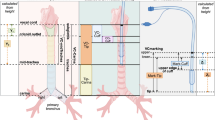Abstract
Background
Incorrect endobronchial placement of the tracheal tube can lead to serious complications. Hence, it is necessary to determine the accuracy of tracheal tube positioning. Markers are included on tracheal tubes, in the process of their manufacture, as indicators of approximate intubation depth. In addition, continuous chest auscultation has been used for determining the proper position of the tube. We examined insertion depth using the cuff depth and continuous chest auscultation method (CC method), compared with insertion depth determined by the marker method, to assess the accuracy of these methods.
Methods
After induction of anesthesia, tracheal intubation was performed in each patient. In the CC method, the depth of tube insertion was measured when the cuff had passed through the glottis, and again when breath sounds changed in quality; the depth of tube insertion was determined from these values. In the marker method, the depth of tube insertion was measured and determined when the marker of the tube had reached the glottis, using insertion depth according to the marker as an index.
Results
Insertion depth by the marker method was 26.6 ± 1.2 cm and by the CC method was 28.0 ± 1.2 cm (P < 0.0001). The CC method indicated a significantly greater depth than the marker method.
Conclusion
This study determined the safe range of tracheal tube placement. Tube positions determined by the CC method were about 1 cm deeper than those determined by the marker. This information is important to prevent accidental one-lung ventilation and accidental extubation.
Clinical trial registration
UMIN No. UMIN000011375.




Similar content being viewed by others
References
Brunel W, Coleman DL, Schwartz DE, Peper E, Cohen NH. Assessment of routine chest roentgenograms and the physical examination to confirm endotracheal tube position. Chest. 1989;96(5):1043–5.
Schwartz DE, Lieberman JA, Cohen NH. Women are at greater risk than men for malpositioning of the endotracheal tube after emergent intubation. Crit Care Med. 1994;22(7):1127–31.
Minonishi T, Kinoshita H, Hirayama M, Kawahito S, Azma T, Hatakeyama N, Fujiwara Y. The supine-to-prone position change induces modification of endotracheal tube cuff pressure accompanied by tube displacement. J Clin Anesth. 2013;25(1):28–31.
Fauzdar S, Kraus J, Papageorge M. Vocal cord paralysis following orthognathic surgery intubation. Ann Maxillofac Surg. 2011;1(2):166–8.
Mitsuda S, Moriyama K, Yorozu T. Optimal insertion depth of endotracheal tube among Japanese. J Anesth. 2014;28(3):477.
Schwartz N. Monitoring bilateral breath sounds. Anesthesiology. 1987;66(5):711–2.
Sugiyama K, Manabe Y, Kohjitani A. Unrecognized bronchial intubation associated with the uncuffed pediatric tracheal tube with bilateral Murphy eyes. Paediatr Anaesth. 2012;22(12):1191–6.
Sugiyama K, Yokoyama K. Reliability of auscultation of bilateral breath sounds in confirming endotracheal tube position. Anesthesiology. 1995;83(6):1373.
Sugiyama K, Yokoyama K, Satoh K, Nishihara M, Yoshitomi T. Does the Murphy eye reduce the reliability of chest auscultation in detecting endobronchial intubation? Anesth Analg. 1999;88(6):1380–3.
Nooh N, Abdelhalim AA, Abdullah WA, Sheta SA. Effect of remifentanil on the hemodynamic responses and recovery profile of patients undergoing single jaw orthognathic surgery. Int J Oral Maxillofac Surg. 2013;42(8):988–93.
Chen J, Zhou JQ, Chen ZF, Huang Y, Jiang H. Efficacy and safety of dexmedetomidine versus propofol for the sedation of tube-retention after oral maxillofacial surgery. J Oral Maxillofac Surg. 2014;72(2):285 e1–7.
Ansari L, Bohluli B, Mahaseni H, Valaei N, Sadr-Eshkevari P, Rashad A. The effect of endotracheal tube cuff pressure control on postextubation throat pain in orthognathic surgeries: a randomized double-blind controlled clinical trial. Br J Oral Maxillofac Surg. 2014;52(2):140–3.
Turkstra TP, Smitheram AK, Alabdulhadi O, Youssef H, Jones PM. The Flex-Tip tracheal tube does not reduce the incidence of postoperative sore throat: a randomized controlled trial. Can J Anaesth. 2011;58(12):1090–6.
Jafari A, Gharaei B, Kamranmanesh MR, Aghamohammadi H, Nobahar MR, Poorzamany M, Shahrabi M, Solhpour A. Wire reinforced endotracheal tube compared with Parker Flex-Tip tube for oral fiberoptic intubation: a randomized clinical trial. Minerva Anestesiol. 2014;80(3):324–9.
Sugiyama K, Manabe Y, Kohjitani A. The Parker Flex-Tip(R) tube prevents subglottic impingement on the tracheal wall during nasotracheal intubation. Anesth Analg. 2012;115(1):212–3.
Acknowledgments
This work was supported by the departmental research fund of Kagoshima University.
Author information
Authors and Affiliations
Corresponding author
Ethics declarations
Conflicts of interest
The authors have no conflicts of interest relevant to this article to disclose.
Financial disclosure
The authors have no financial relationships relevant to this article to disclose.
About this article
Cite this article
Ouchi, K., Sugiyama, K. Cuff depth and continuous chest auscultation method for determination of tracheal tube insertion depth in nasal intubation: observational study. J Anesth 30, 193–198 (2016). https://doi.org/10.1007/s00540-015-2110-0
Received:
Accepted:
Published:
Issue Date:
DOI: https://doi.org/10.1007/s00540-015-2110-0




